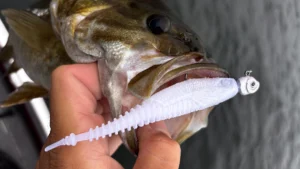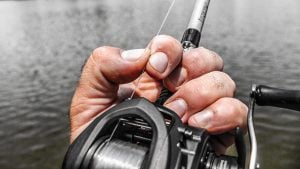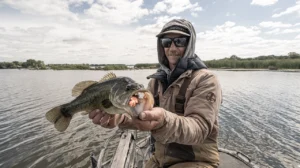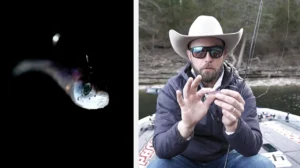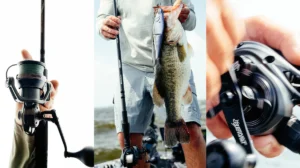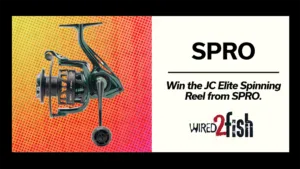When it comes to bass fishing, there are certain lures that get all the glory. Whether it’s a jig, swimbait, crankbait, or soft plastic, every bait category has some type of hype. There’s one bait that flies under the radar that flatout catches fish when conditions call for it — the spybait.
At first glance, this hard bait doesn’t look like much. It’s a slender, minnow-shaped bait with tiny props on the front and back. Compared to the flash of a jerkbait or bold wobble of a crankbait, the spybait almost looks plain, too subtle for a bass. But that subtlety is exactly why it shines. When the bite gets tough, when the water is clear, and when bass are pressured, the spybait can be deadly. I’ll break down exactly what a spybait is, how it works, and how I fish it throughout the season.
What Is A Spybait?
A spybait is a finesse hard bait, most commonly between three and five inches long and weighing around 1/4 to 1/2 ounce. The defining feature is the two small propellers. When retrieved, those props spin to create a subtle vibration and bubble trail.
Unlike a jerkbait that darts or a crankbait that thumps, a spybait’s action is more of a smooth, rolling shimmy with just enough flash to mimic a struggling baitfish. During the fall, the bait will shimmy and stay horizontal, also triggering strikes. Think of it as a lure that whispers instead of shouts.
The technique of spybaiting actually came from Japan, where clear, pressured fisheries forced anglers to get creative. Companies like Duo Realis popularized the lure in the states. Ever since, more bass fishermen have been realizing its power, especially on clear lakes with big spotted bass and smallmouth.
Why Subtlety Works
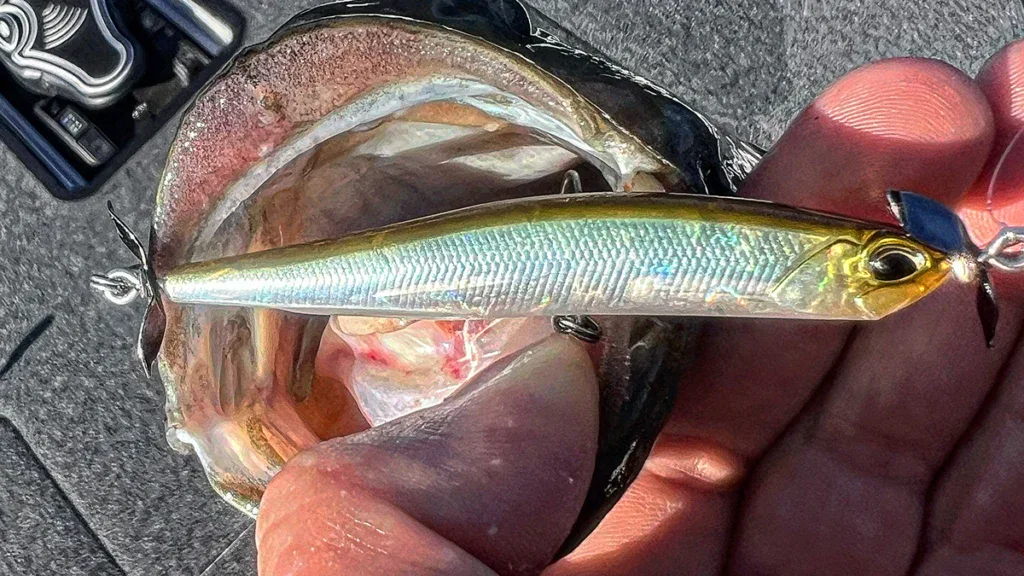
Bass are predators, but they’re not pushovers. In highly pressured lakes or extremely clear water, they’ve seen every type of bait you can throw at them. Big flashy lures often spook more fish than they fool.
That’s where a spybait comes into your rotation. It’s designed to be fished on a light line, slowly retrieved, and presented naturally. The props and shimmy give it just enough life to fool fish into thinking it’s an injured baitfish, but not so much that it looks unnatural. The result is a bait that bass don’t have to think twice about. It looks like a small, easy meal drifting through their zone that’s hard to pass up.
The Perfect Spybait Setup
Fishing a spybait isn’t compatible with standard bass gear and heavy line; instead it’s finesse fishing to the core. You need the right gear to make it work. Here is a breakdown of what I use to fish a spybait.
- Rod: A medium-light spinning rod, between seven and seven and a half feet in length, with a soft tip but enough backbone to handle a big fish. You want something with a parabolic bend to keep those small treble hooks pinned. Remember, this is a hard bait, you don’t want the fish throwing the trebles. The Alpha Angler Spybait Rod is hard to beat.
- Reel: Surprisingly, I like a bigger spinning reel for this. Something in the 3000- to 4000-size with a smooth drag system. The larger arbor of the bigger spinning reel allows me to take in more line and have better control over the fish. I am a huge fan of the Shimano Vanford because of its extremely buttery drag system.
- Line: This part is the critical component in fishing a spybait. I run a mainline of five- to eight-pound Cortland Masterbraid to a five- to seven-pound Sunline FC Sniper fluorocarbon leader. The fluoro is key because it sinks, keeps the bait down, and is nearly invisible in clear water. I understand it’s odd to see those size lines mentioned, but trust me those light lines work great.
- Hooks: Most spybaits come stock with quality trebles, but I always check them. I usually swap them out with Gamakatsu G-Finesse trebles due to their strength in a light wire package. Finesse baits like spybaits don’t forgive dull or weak hooks.
How To Fish A Spybait

Here’s the beauty of a spybait: It’s a very simple way to fish. Unlike jerkbaits that require a rhythm or topwaters that need walking, the spybait is mainly a chuck-and-wind kind of bait. But there are little details that make all the difference. Here are some things to consider when fishing a spybait.
- Make as long of a cast as you can. The farther, the better. Spybaits are designed to cover water and look natural from start to finish.
- Count down your baits to get it at the right depth the fish are at, or where you see them on your graph. These lures sink slowly at about one foot per second on average. If you want to target bass in 10 feet of water, let it sink for a 10-count before starting your retrieve.
- Just keep a slow and steady retrieve. This is the heart of spybaiting. Just reel slowly and evenly, letting the lure do its thing. No jerks, no twitches or pops, just stay smooth and consistent.
- Pause the bait every now and then to let it fall. Once every few casts in deeper water, I’ll stop reeling for a second or two. The spybait will shimmy and fall like a dying minnow, and usually I’ll pick up one or two more bites doing this.
- Your hookset is something you need to pay attention to. Don’t swing for the fences like you would with a jig. With light lines and small trebles, a steady sweep set works best. Just reel into the fish and apply pressure. Almost the same as you would a dropshot hookset, except horizontally instead of vertically.
When and Where To Use A Spybait
Spybaits are mainly used in very specific situations. While you can catch fish throughout the water column under a variety of conditions, spybaiting is a fairly condition specific technique. For them to truly eat the bait well, the conditions and fish have to align. Here are some conditions and fish patterns where a spybait excels.
- Water Clarity: A spybait shines in clear water. If you can see more than four to five feet into the water, a spybait is in play. Bass are usually eating a spybait based on sight, so having good water clarity is crucial to bites.
- Suspended Fish: Spybaits excel at targeting suspended fish around points, humps, or over deep water. Before the invention of Livescope, this is how we were able to get those suspended fish to cooperate and bite. All it takes is a little shimmy to get them to bite.
- Post Spawn and Heat Of The Summer: This is the time of year where bass are the most pressured and stressed. Oftentimes it takes little subtleties to get them to bite and a spybait is a great bait to get them to bite.
- Sun Versus Clouds: Since this is more of a visual bait for bass, having sunny conditions is more favorable as bass can see and hunt down the bait. Spybaits will work on cloudy conditions, but it has to be in shallow water, we are talking 10 feet or less.
Common Mistakes To Avoid
Even though spybaiting is very straightforward, there are some mistakes to avoid. I spoke with Capt. Andy Full, of Full’s Fishing Guide Service, out of Buffalo, NY, about the mistakes he sees anglers regularly commit.
Full knows a thing or two about spybaiting on the Great Lakes, especially the eastern portion of Lake Erie. When he’s not co-hosting the Serious Angler Podcast, Full is constantly trying to put the pieces of the puzzle together for his clients. A spybait is one of those baits he can count on to put fish in the boat.
“The biggest problem I’ve seen as a guide is the hookset with a spybait,” said Full. “Clients are always wanting to set the hook hard when they get that subtle bite. They get super excited and 95 percent of the time they lose the fish.”
Remember, these baits have treble hooks and are extremely subtle. If you set the hook too hard, you will pull the bait right out of the fish’s mouth.
“It is important to not set the hook when you feel a fish bump or grab the bait,” he said. “Just keep reeling until the rod loads up and make a slow long sweeping motion with the rod. That sweep set will keep the fish pinned.”
A loose drag in combination with this will result in more fish landed. Fighting fish on a spybait is a bit of a grey area, explained Full. What he means by this is not putting too much pressure when fighting them, but maintaining pressure to not let them unhook. One wrong little movement when fighting the fish and the fish is gone. When dealing with small treble hooked baits like this, it’s imperative that you take your time with the fight.
Top Spybaits On The Market
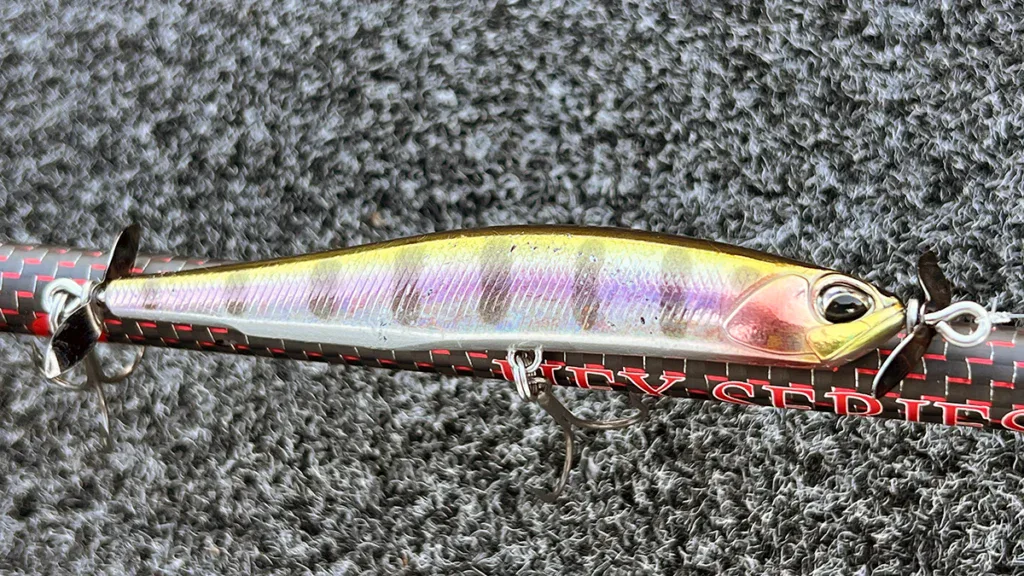
It seems like since the bait’s creation, everyone has come out with their own spybait. Here are three of my favorites that catch fish consistently in my boat.
- Duo Realis Spinbait 80 – This is the original spybait. Duo Realis is the one who invented and created the bait. It has great action, always swims true, and catches fish consistently.
- Lucky Craft Screw Pointer – Designed closely to be a combination of the Duo spinbait and a Lucky Craft Pointer, this spybait has a much wider shimmy and works better in shallow water.
- Berkley Spy – Of all the spybaits on the market, this is the most budget friendly option for someone just getting into spybaiting. They work surprisingly well, but have more of a roll when reeled too fast. When fished deeper, they will produce bites.
Gain Confidence
I’ll be honest, it took me a while to have confidence in spybaits. The first time I tied one on, I thought it was the dumbest thing I’ve ever seen. But the more I used it, the more I saw its potential. Now, it’s one of my go to baits when the bite gets tough. Next time you’re staring at calm, clear water and wondering how to fool bass that just won’t eat, don’t overthink it. Pick up a spybait, make a long cast, and just start reeling. The fish will tell you the rest.



